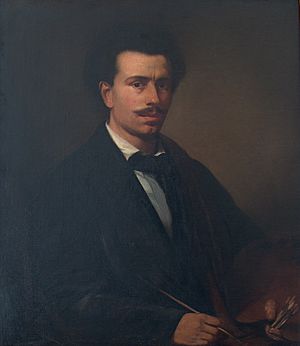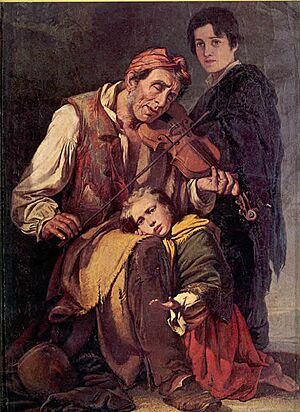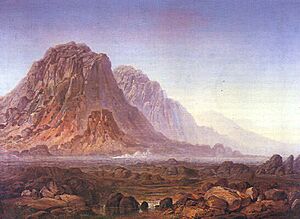José Rodrigues facts for kids
Quick facts for kids
José Rodrigues
|
|
|---|---|

Self portrait of José Rodrigues
|
|
| Born |
José Rodrigues de Carvalho
16 July 1828 |
| Died | 18 February 1887 (aged 58) |
| Nationality | Portuguese |
| Education | Academy of Fine Arts |
| Known for | painting |
|
Notable work
|
See Gallery [1] |
| Movement | Realism |
| Awards | by the Queen Dona Maria II – Gold medal Academy of Fine Arts – Gold medal |
José Rodrigues de Carvalho (born July 16, 1828 – died October 19, 1887) was a talented Portuguese painter. He is best known for his painting O Pobre Rabequista (meaning The Poor Rabequista). This famous artwork was first shown in Paris in 1855 and later in Porto in 1865, where it won a second-place award.
Contents
José Rodrigues' Early Life
José Rodrigues was born in Lisbon, Portugal. His parents were Apolinário José de Carvalho and Maria Leonarda. He was baptized on September 21, 1828. He grew up with five brothers in Lisbon.
In 1863, José Rodrigues married José Maria Rodrigues. They had three children: António Ribeiro, Teresa de Jesus, and Leonor Matilde.
Becoming an Artist
José Rodrigues started his art journey early. In 1841, he became a student at the Academy of Fine Arts. He was a very dedicated student.
- In 1842, he won a prize in a drawing competition.
- In 1843, he showed a drawing at a student exhibition. Other famous artists like Miguel Ângelo Lupi also won awards that year.
- By 1845, he was studying historical painting and won another award.
- In 1846, he received an award for drawing from a live model.
Awards and Recognition
José Rodrigues received many important awards for his art throughout his life.
- In 1849, Queen Dona Maria II gave him a gold medal at an art exhibition.
- The Academy of Fine Arts also gave him a gold medal for his painting "Aparição do Anjo S. Gabriel ao profeta Daniel."
- He won a Silver Medal with honors from the Portuguese Industrial Association.
- In 1865, he was named an "Academic of Merit" by the Academy of Fine Arts. This is a special honor for artists.
Important Paintings for Lisbon
In 1882, José Rodrigues made an agreement with the City Council of Lisbon. He was asked to paint two large, full-body portraits for their main meeting room. These paintings were of important historical figures: Alexandre Herculano and Manuel Fernandes Tomás. You can still see these paintings in the City Council's "Meeting Chamber" today.
Even though he was a talented artist, José Rodrigues often had to paint portraits to earn money. This made him feel sad and even sick sometimes. He also taught art classes at different schools.
José Rodrigues passed away at his home in Lisbon on October 19, 1887.
José Rodrigues' Art Style
José Rodrigues was known for his "Realism" style of painting. This means he tried to paint things as they really looked. He often painted scenes from everyday life, showing people and customs. Sometimes, his paintings also showed a lot of feeling and emotion.
His works are still studied today at the Faculty of Arts of the University of Oporto. They are an important part of 19th-century art history in Portugal.
Famous Works by José Rodrigues
Here are some of José Rodrigues' well-known paintings:
Oil Paintings
- The poor of púcara: This painting used to belong to King D. Fernando.
- The poor rabequista (also called Blind Rabequista): This is one of his most famous works. It shows three figures and is now at the Chiado Museum.
- The malmequer: This painting belonged to D. Rufina Maria Iglesias of Lima.
- (Cliffs of La Mancha): This painting was owned by the Marquis de Sousa Holstein.
- The old vegetable seller in Sintra: This painting belonged to King D. Luis.
- The peasant: Also owned by King D. Luis.
- Margins of the Tagus river, around Santarém: Another painting that belonged to King D. Luis.
- Lady of Good luck: This painting belonged to D. Rufina Maria Iglesias of Lima.
- Flowers and fruit: This large painting was owned by King D. Fernando.
- The city: A very large painting for the Lisbon Municipal Council, completed in 1883.
Oil Portraits
José Rodrigues painted many portraits of important people:
- King Pedro V (several portraits)
- Cardinal Patriarch of Lisbon, D. Manuel Bento Rodrigues
- King Louis (several portraits, including one for the University of Coimbra)
- Self-portrait of the artist at nineteen years old.
- Self-portrait of the painter, dressed in a cape and hat.
Gallery
See also
 In Spanish: José Rodrigues para niños
In Spanish: José Rodrigues para niños








